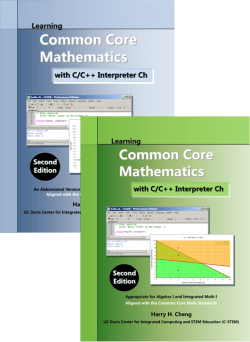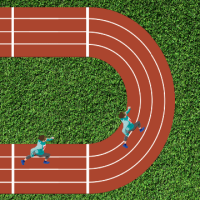Curriculum
“The UC Davis C-STEM curriculum is a godsend to me. I used to spend hours trying to develop just one coding lesson for my mathematics students, but now I have a ready-made curriculum and I am free to teach coding to my heart’s content, while also providing my students the opportunity to interweave algebra, computer coding, and robotics.”.— Doug Obrigawitch, Math Teacher and Department Chair, Manteca High School, California
“Unlocking a well hidden truth: Math can be a wonderfully creative and useful tool, not only in school but in your everyday life. Using Ch as a medium allows students to be the artists and algebra to be the paintbrush.“
– Chris Schlesselman, Lead CTE Teacher, Technology & Engineering Design Academy, Hiram W Johnson High School

Higher Education Conceptualized, Industry Motivated, Teacher Validated
The C-STEM Math/CS/Engineering Design Curriculum and C-STEM CTE Information and Communication Technology (ICT), and Engineering Pathway provide K-12 students with 13 years of hands-on integrated math, science, and computer science education, in compliance with Common Core Math, CS Standards, and Science Standards with coding in RoboBlocky and Ch/C/C++.
The C-STEM Math/CS/Engineering Design formal curriculum complements RoboPlay Challenge Competition, Afterschool and Summer Robotics Camps and Robotics-Math Camps, and GIRL/GIRL+ Summer Camps with project-based learning.
C-STEM curriculum includes teaching strategies, textbooks, and courseware with:

- Lesson Plans
- C-STEM Textbooks
- PowerPoint Lessons
- Video Lessons
- Group Computing Activities
- Optional Robotics Activities
A-G courses fulfill subject requirements for freshman admission to the University of California and California State University systems. C-STEM has UCOP A-G Status. UCOP A-G Approved C-STEM courses can be readily added in a high school’s A-G course list.
The C-STEM curriculum can be used in multiple ways such as:
- Four Weeks as Supplementary Materials for STEM Courses
- One Semester Course
- Full-Year Course in Formal Curriculum
- Multi-Year Career Pathways or Academies
- 13-Year C-STEM ICT Pathway
- Afterschool Programs
- Robotics Camps in Both Academic Year and Summer in School Campuses and Colleges
Additional information about support for implementation of the C-STEM program can be found in the Program Support Page.


RoboBlocky allows teachers without any prior coding, robotics, and Arduino experience to get started quickly. The C-STEM Math and CS with Robotics curriculum are compliant with the Common Core Math Standards and CS Standards.
C-STEM provides teachers with professional development opportunities, with an option to get CS Supplementary Teaching Credential, on how to implement our rigorous curriculum in their teaching. No prior computer programming and robotics experience is necessary to integrate and implement our curriculum.
Why learn C Programming?
- C is one of the most commonly used programming languages in industry. A majority of desktop applications, including Word, PowerPoint, and various browsers, are developed in C or its close relative C++. Many games and robotic applications are also programmed in C/C++.
- C is one of the foundations for modern information technology and computer science.
- C is a standardized programming language with international standards.
- Writing computer programs is essential to solving complex science and engineering problems.
- Computer programming is becoming a necessary skill for many professions.
- Computer programming can develop your critical thinking capabilities.
- C is one of the most commonly used programming languages in colleges and universities.
- C is the language of choice for programming embedded and mechatronic systems with hardware interface. All robot control software is programmed in C/C++.
- C excels as a model programming language. All other new languages follow the design of C.
- Once you have learned C, you can pick up other languages without much difficulty by yourself because all other modern languages borrowed heavily from C.
- ( More information from experts about why learn C )
2022 Programming Language Rankings by IEEE Spectrum
IEEE Spectrum ranked C and C++ as two of the top three programming languages in 2022

“The C-STEM curriculum will benefit students by providing them with the necessary critical thinking and problem solving skills that the job market requires. I feel that in our current curriculum ideas and facts are stressed more than strategies and analytic skills. In my opinion, by stressing the strategies and skills needed to solve problems, rather than focusing on all the individual problems themselves, our students will be fully equipped to tackle any obstacle. The C-STEM curriculum will provide such skills.”
– Ryan Mangan, Engineering Teacher, School of Engineering and Sciences
“I used the C-STEM Algebra curriculum last year. The material provided students with real-world skills proving math to be both applicable and enjoyable. Standards-aligned and user-friendly computing activities are an exceptional addition to my Algebra I curriculum because it helps make abstract ideas concrete and allow students to apply mathematical concepts to the real world.”
– Francesca DeFazio, Math Teacher and MA, Westmore Oaks Elementary School
